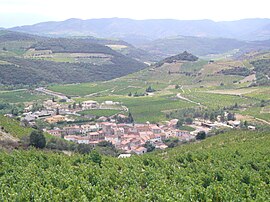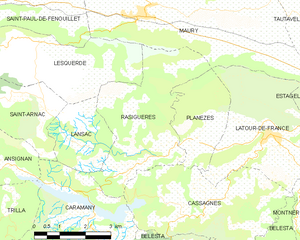| Rasiguères Rasiguèras | |
|---|---|
| Commune | |
 A general view of Rasiguères A general view of Rasiguères | |
 Coat of arms Coat of arms | |
| Location of Rasiguères | |
  | |
| Coordinates: 42°46′00″N 2°36′34″E / 42.7667°N 2.6094°E / 42.7667; 2.6094 | |
| Country | France |
| Region | Occitania |
| Department | Pyrénées-Orientales |
| Arrondissement | Prades |
| Canton | La Vallée de l'Agly |
| Intercommunality | Agly Fenouillèdes |
| Government | |
| • Mayor (2020–2026) | Paul Foussat |
| Area | 13.72 km (5.30 sq mi) |
| Population | 166 |
| • Density | 12/km (31/sq mi) |
| Time zone | UTC+01:00 (CET) |
| • Summer (DST) | UTC+02:00 (CEST) |
| INSEE/Postal code | 66158 /66720 |
| Elevation | 104–548 m (341–1,798 ft) (avg. 182 m or 597 ft) |
| French Land Register data, which excludes lakes, ponds, glaciers > 1 km (0.386 sq mi or 247 acres) and river estuaries. | |
Rasiguères (French pronunciation: [ʁaziɡɛʁ] ; Occitan: Rasiguèras; Catalan: Rasigueres) is a commune in the Pyrénées-Orientales department in southern France.
Geography
Localisation
Rasiguères is in the canton of La Vallée de l'Agly and in the arrondissement of Perpignan. It gained particular recognition in 1981 when the pianist, Dame Moura Lympany, who lived in the village, established the Festival of Music and Wine which ran successfully for several years.

| Places adjacent to Rasiguères | ||||||||||||||||
|---|---|---|---|---|---|---|---|---|---|---|---|---|---|---|---|---|
| ||||||||||||||||
Population
| Graphs are unavailable due to technical issues. Updates on reimplementing the Graph extension, which will be known as the Chart extension, can be found on Phabricator and on MediaWiki.org. |
| Year | Pop. | ±% p.a. |
|---|---|---|
| 1968 | 228 | — |
| 1975 | 152 | −5.63% |
| 1982 | 162 | +0.91% |
| 1990 | 165 | +0.23% |
| 1999 | 168 | +0.20% |
| 2007 | 139 | −2.34% |
| 2012 | 167 | +3.74% |
| 2017 | 152 | −1.86% |
| Source: INSEE | ||
Sites of interest
- A fine cave cooperative, Cellier de Trémoine
- A fortified tower from the 15th c. with remaining parts of ramparts.
- An old bridge from the 16th and 17th c. on the river Tournefort.
- The ruins of the Trémoine family castle with walls from the 13th c. and a tower from the 16th and 17th c.
- Ruins of the Castellas tower from the 12th and 13th c.
- The Saint John the Baptist Church from the 18th and 19th c.
- Remains of an old church near the Tournefort bridge.
- Various old stone sheds in the vineyards.
See also
References
- "Répertoire national des élus: les maires". data.gouv.fr, Plateforme ouverte des données publiques françaises (in French). 2 December 2020.
- "Populations de référence 2022" (in French). The National Institute of Statistics and Economic Studies. 19 December 2024.
- Population en historique depuis 1968, INSEE
- (in French) Fabricio Cardenas, Vieux papiers des Pyrénées-Orientales, Quête insistante du curé de Rasiguères en 1887 , 11 June 2015
This Pyrénées-Orientales geographical article is a stub. You can help Misplaced Pages by expanding it. |